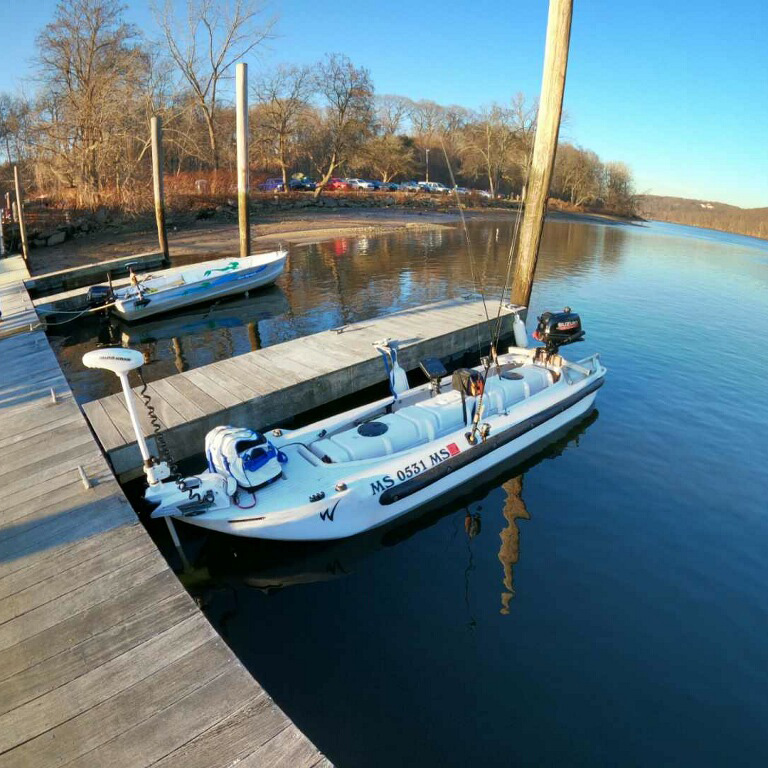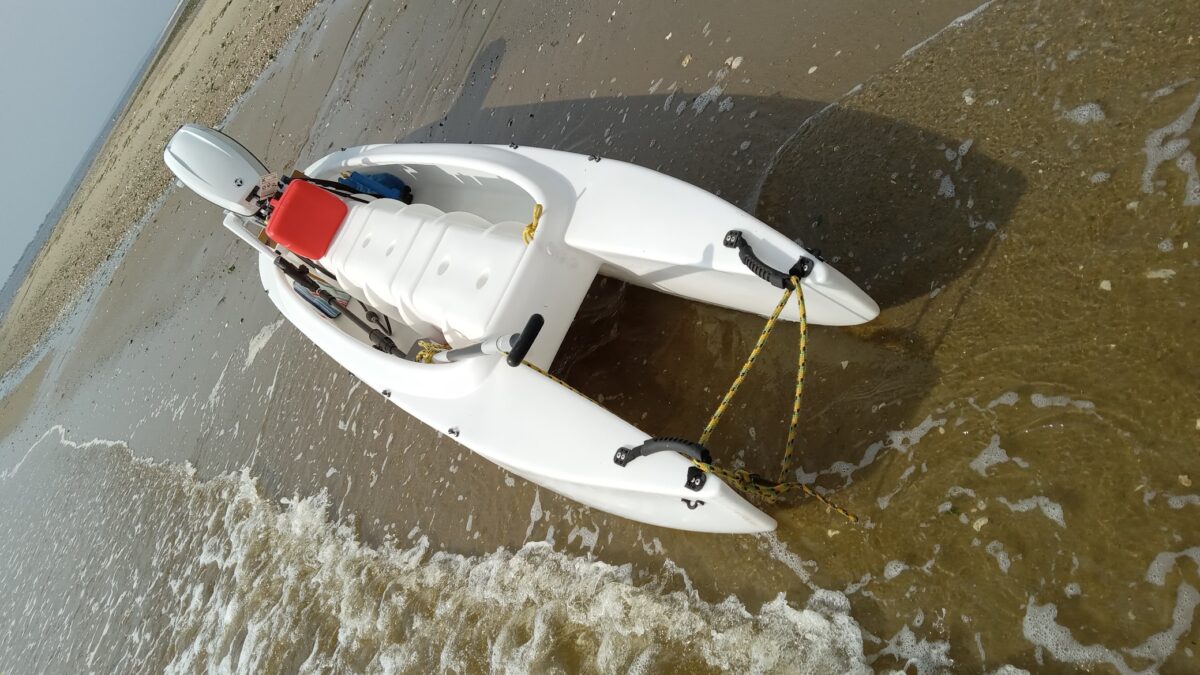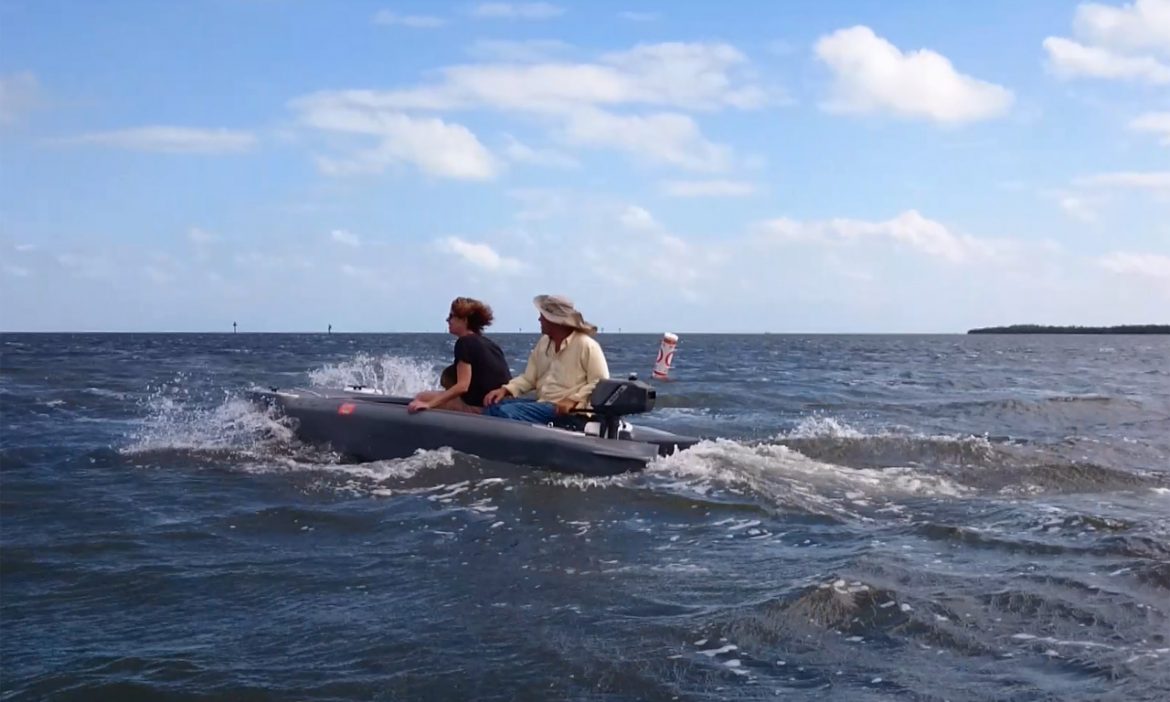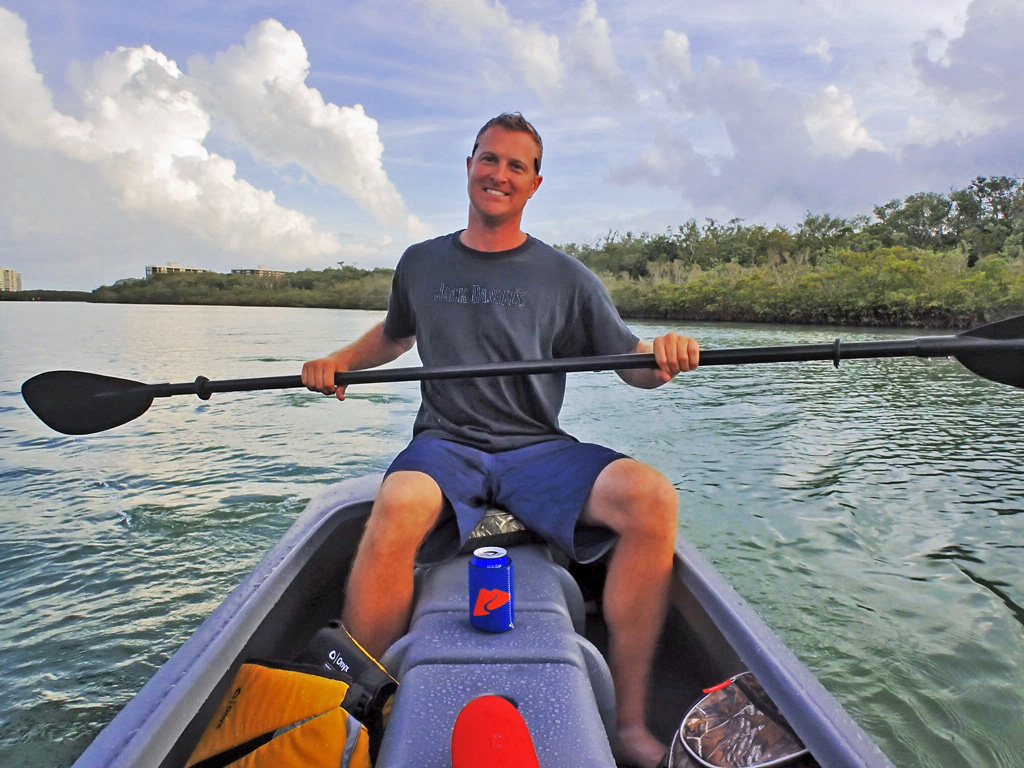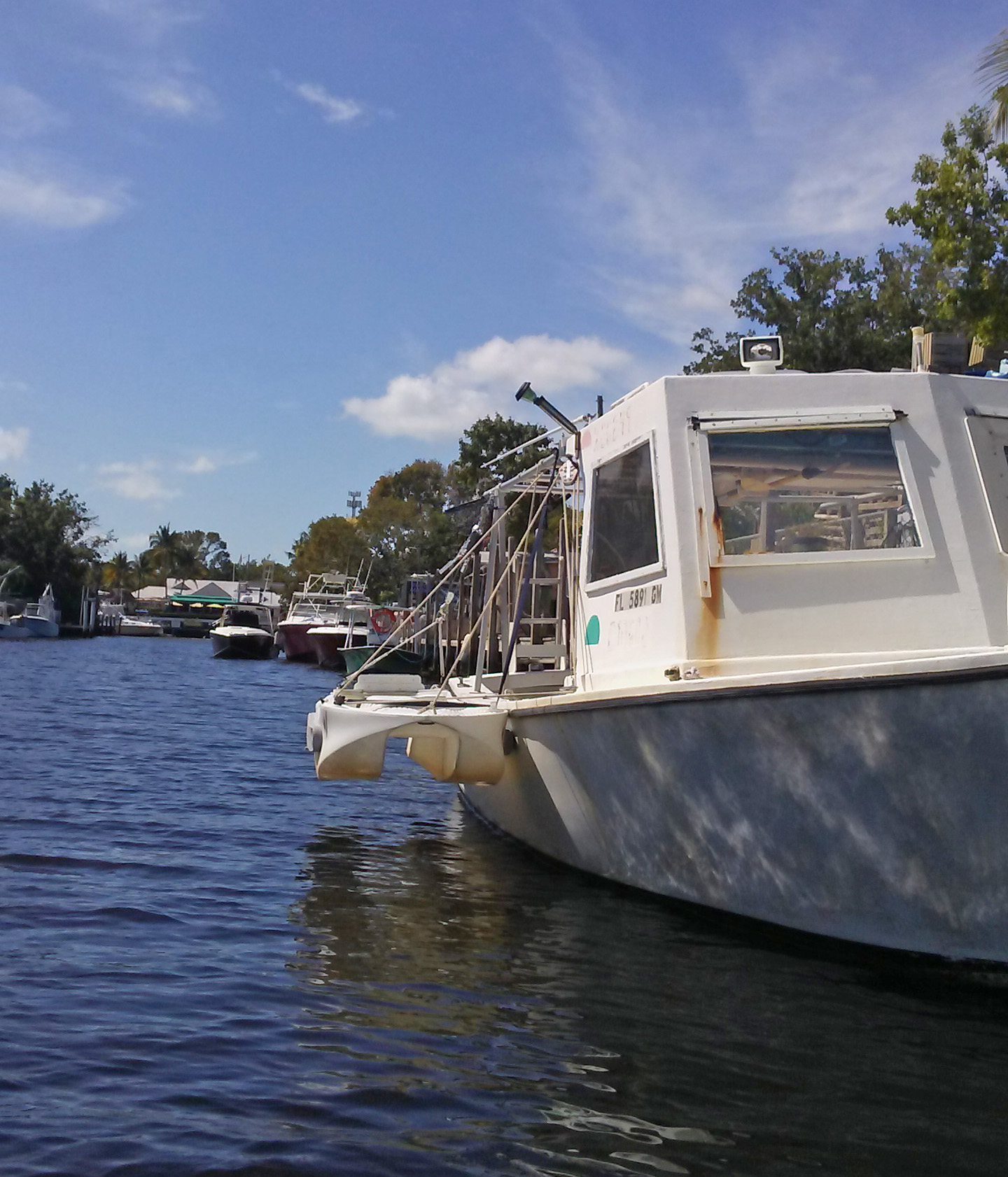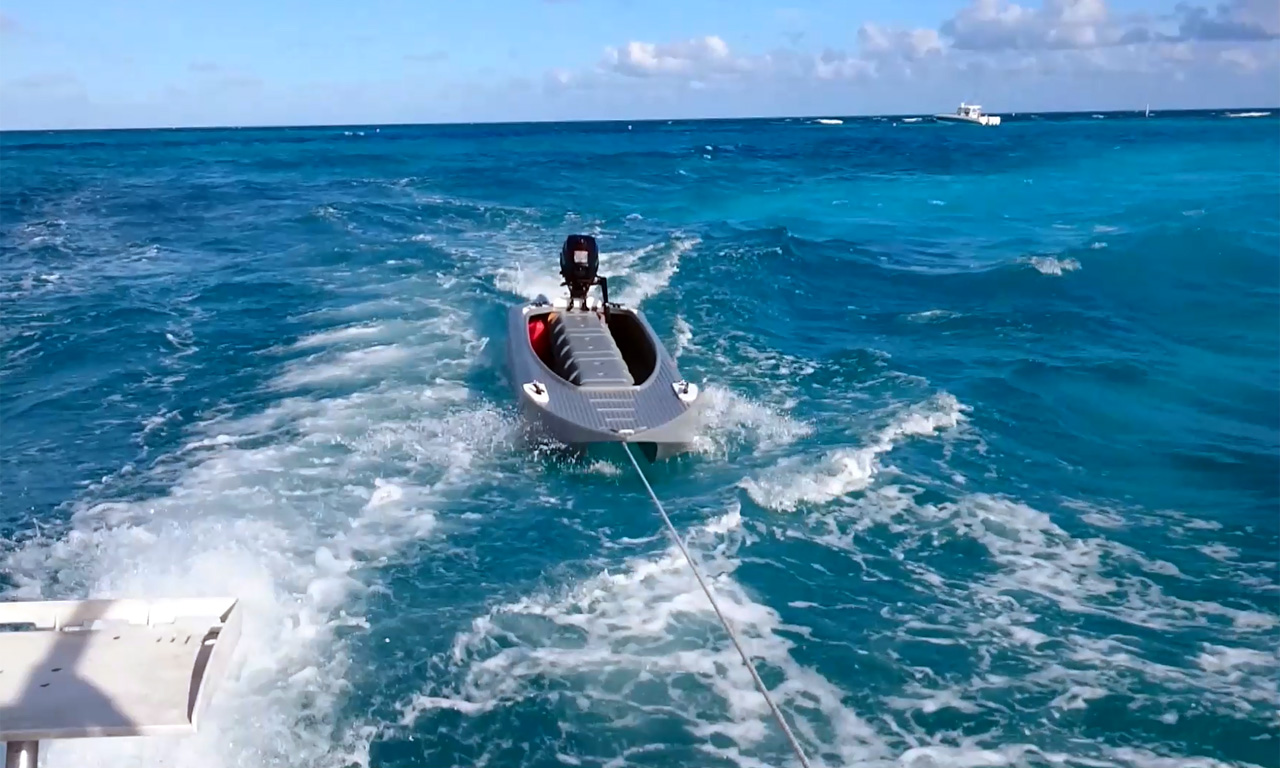Fishing Kayak or Small Boat?
Anglers, experienced or new to fishing, who fish on a budget, and/or don’t like the hassle involved in owning and operating a big boat, ask themselves whether they should fish out of kayaks or small boats (including microskiffs), since both types of watercraft offer similar advantages in terms of low cost, low maintenance, and the fact that both require reduced space for storing them, compared to big boats.
This article compares top of the line, full-size, fully accessorized SOT and sit-in kayaks that are designed specifically for fishing, to small boats, including Jon boats, small microskiff, dinghies, and square-stern canoes designed to be outfitted with small outboard gas motors.
- In addition, at the end of every topic, we will include a few words on how Wavewalk’s W720 kayak skiff and S4 cartop microskiff compare to conventional kayaks, small boats, and conventional microskiffs
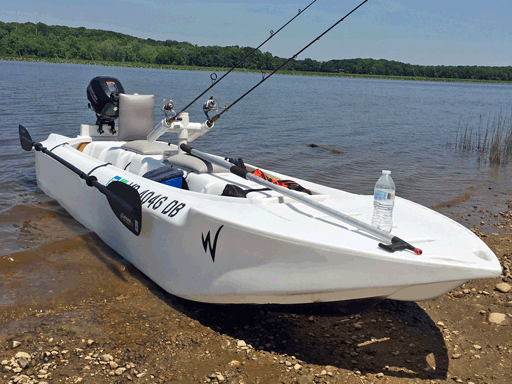
Content –
- Price and Cost of Ownership
- Propulsion and Power
- Physical Exercise vs Range of Travel
- Safety
- Stability
- Basic Comfort – The Seat Problem
- Kayaks’ Foot Braces – More Discomfort
- Fishing Functionality (a.k.a. ‘Fishability’)
- A Standing Problem
- Lean at Your Own Risk – The Lean Bar
- Steering
- Onboard Storage
- Transportation and Carrying
- Multiple Users
1. Price and Cost of Ownership
Low cost seems to be the main attribute that makes both kayaks and small boats attractive to most people who use them for fishing, so we’ll start by discussing the economics of owning a fishing kayak and a small motorboat.
How much does a good fishing kayak cost?
It’s hard to tell, but since there are dozens of fishing kayaks priced at over $2,500, among which quite a few that cost over $3,000, we conclude that a top of the line fishing kayak costs over $2,500. According to Yaklogic.com, the average price of a pedal driven kayak is around $2,700.
Conclusion? -Fishing kayaks are not cheap.
How much does a small boat cost?
This is truly impossible to tell, due to the huge range of types and models, but a quick look on the Internet would reveal that a 15 ft brand name Jon boat can cost as little as $1,500, and a 14 ft Jon boat can cost less than $1,000. Both sums are for the boat itself with neither a motor nor a trailer.
A popular board-style microskiff for a single person costs less than $2,000 without shipping, and another board-style “skiff” is offered for $3,500. However, some microskiffs cost over $20,000, but arguably, they are too big ticket items to be called small boats.
A small outboard motor costs between one thousand and a few thousand dollars, and a trailer for a small boat costs less than a thousand dollars, so the total cost of a small boat, is still in the same ballpark as the cost of an expensive kayak, especially since the biggest kayaks weigh over 120 lbs, and require a trailer for transportation.
In sum, an expensive fishing kayak can cost the same and more than an inexpensive small boat, and if you need a trailer to transport it, you have the same footprint in your driveway, or your backyard, and this means a similar cost of ownership.
- The W720 kayak skiff is priced at $2,350, and the S4 car-top cat microskiff at $2,750. Both the W720 and S4 can be car topped by one person, so buying a trailer to transport them is truly optional. Conclusion? Despite their superior design and performance compared to kayaks and small boats, neither the W700 nor the S4 are much more expensive.
2. Propulsion and Power
Technically, propulsion is the main difference between kayaks and small fishing boats. Kayaks are essentially human powered, namely paddled or pedaled, while small boats are motorized, and they are hard and sometimes even impossible to propel without a motor. Even the smallest outboard gas engine is many times more powerful than a human being, or a tandem crew, and this fact makes a big difference. Outboard gas motors are more powerful than electric motors too, but in our view, any motor is better than no motor, for a number of reasons that will be discussed here.
- Both the W700 and S4 can be easily and effectively paddled with either canoe or kayak paddles, and both can be easily and effectively motorized with powerful outboard gas motors. Some S4 owners outfit their boat with a powerful gas outboard motor at the stern, and a silent electric trolling motor at the bow, bass-boat style.
3. Physical Exercise vs Range of Travel
Kayaks offer an advantage to anglers who want to get some physical exercise while they look for fish, but this advantage turns into a problem for people who focus solely on catching fish, since kayaks severely limit both their range of travel and on the time they can spend fishing, since due to their slowness, kayaks force their users to spend more time traveling to fisheries and back from them.
Motorboats are much faster than human powered kayaks, and their range of travel is many times bigger. However, they are more limited than kayaks as far as launching and beaching are concerned, as well as in their ability to go in shallow water, except when compared to pedal driven kayaks that draft more than regular, paddle kayaks.
- The W700 and S4 have a range of travel of a small motorboat, and both are very pleasant to paddle, more than kayaks are, since Wavewalk paddlers ride a comfortable, high saddle-sea, and they are not required to sit in the notorious L kayaking position. The W700 and S4 deliver the best in both worlds (and some more).
4. Safety
Neither kayaks nor small fishing boats may be considered as seaworthy in the full sense, because they cannot go in the ocean or on big rivers and lakes when weather and water get rough. However, boats are safer than kayaks, whose feeble human propulsion limits their ability to cope with wind, waves, and currents. In other words, your chances of being swept offshore are much greater if you’re paddling oe pedaling a kayak than if you’re driving a small motorboat.
Another reason why kayaks are less safe than small boats is that they provide less free board and less stability, which is why kayakers are more exposed to the elements, and are more likely to fall overboard or flip their kayaks. This leads us the the next subject, which is the most important of all:
5. Stability
Even the biggest and widest SOT and sit-in kayaks deliver stability that’s sub par compared to a typical, average size small boat. Simply, the stability that monohull (conventional) kayaks deliver is sub minimal, and stability is the key factor that drives both safety and comfort. If you are not stable you cannot be safe – Your body is good at recognizing unsafe conditions, and it would try to alert you about your instability, and respond to it, and as long as it does, you will feel neither relaxed nor confident, which inevitably means that you won’t be comfortable. Sitting in an expensive padded seat won’t change much for you (see next paragraph) –
- The W700 catamaran kayak is more stable than any SOT or sit-in out there, and the S4 cat microskiff is more stable than any boat of comparable size.
6. Basic Comfort – The Seat Problem
In the past decade, SOT and sit-in kayak manufacturers became aware of the back pain problem that users experience when paddling and fishing while being seated in their kayaks in the L position. So these manufacturers stuffed their kayaks’ seats with more foam and more gel, without achieving noteworthy results: Their kayaks kept being uncomfortable for most people to use, and they kept inducing back pain and leg numbness.
Then came the new trend of higher kayak seats, and seats offering adjustable height. These larger seats are typically made from woven material stretched over a light metal frame, and their shape is reminding of beach seats or stadium seats.
The basic idea behind this kayak seat design is to allow the user to sit a few inches higher, and by doing so alleviate some of the pressure exerted on their lower back, also known as lumbar spine, as well as decrease the stress from the kayaker’s legs.
Does this ergonomic system work? -Sadly, no, and the reason has to do with the faulty ergonomic reasoning behind it: The fact that the angler sits higher yet they keep their basic L position with their legs stretched in front of them makes it more challenging for them to balance their kayak, since the kayak’s center of gravity (CG) goes higher, without its user gaining better means to stabilize either themselves or their kayak.
The only thing you can do while seated in such kayak seats is try to stretch your legs a little more, and increase muscle tension in them. This means you have to make a bigger physical effort, continuously, and therefor exert more horizontal pressure on your back. The increased effort and muscle tension increases your discomfort, fatigue, as well as back pain – Problem unsolved.
On top of this, the seat’s higher and wider backrest is in the way of the kayaker’s shoulders and upper arms when they paddle and cast lines. It further restricts the little range of motion they have, and further limits their ability to change positions and give their back and neck some respite.
Simply put, the L kayaking position imposed by the unstable mono-hull kayak design is the cause of an unsolvable problem, which means that it is not a really a problem, but a given. The only way to paddle a kayak and fish from it without feeling discomfort and pain is to do it riding the saddle of a Wavewalk catamaran kayak.
Unlike kayaks, small boats offer a range of seats, from simple benches to high swivel seats, which enable normal sitting, and this makes them ergonomically superior to kayaks. The only exception to this rule are some motorized boards classified as microskiffs that feature box-like seats that provide too little comfort when the user drives with one arm reaching behind them to hold the motor’s tiller, and their legs stretched forward in an attempt to offer some balance. A kayak or boat that fails to offer its driver good means to balance themselves, is effectively less stable.
- Wavewalk’s patented twin-hulled watercraft feature high saddle seats similar to the seats in personal watercraft (PWC / Jet-ski), All-Terrain Vehicles (ATV), motorcycles, and other high-performance vehicles. The driver and passengers ride these seats with a leg in each hull, in the most stable and ergonomic manner possible on a small boat. Whether you ride the Wavewalk saddle or stand with a foot on each side, you’re guaranteed not to suffer from back problems as a result.
7. Kayaks’ Foot Braces – More Discomfort
To begin with, the big ‘barge’ kayak’s cockpit features sophisticated foot braces that take too much room away from the user’s feet and legs. Let’s face it – being seated for a long period of time is not a pleasant thing, especially when you’re wet or partially wet, and you’re stuck in the notorious L kayaking posture that causes discomfort, leg numbness and back pain. Therefore, being able to move your legs is important, and restricting the space available for your feet and legs to move can only aggravate the problem – Think traveling coach in an airliner, and the magnitude and severity of this ergonomic problem would become clearer to you, especially if you’re neither a small, skinny, or young and physically fit person.
Small boats do not force their users and passengers to sit in postures that are uncomfortable to them, and they don’t force them to stick their feet in any particular location. This is an significant ergonomic advantage that most small boats have over SOT and sit-in kayaks.
- The W700 and S4 do not feature foot braces, or any other limitation on the driver and passengers’ feet. Elderly Wavewalk owners and owners who suffer from various back problems report spending entire days in their W700 and S4 without feeling any physical problem.
8. Fishing Functionality (a.k.a. ‘Fishability’)
Kayak manufacturers strive to make their fishing kayaks appeal to anglers, but this continuous effort produces designs that are increasingly dysfunctional, and in other words, lack ‘fishability’ –
The most obvious manifestation of this trend is the proliferation of expensive, enormous, extra-wide, heavy and cumbersome, hard to paddle and pedal, and practically impossible to carry or car top kayaks dubbed ‘barges’. Barges are hard for their owners to move on land and on water.
But it’s not just the size of those beastly yaks that makes one wonder whether they may actually defeat the purpose of kayak fishing, that is fishing from a nimble and portable craft, nor the fact that their manufacturers tout them as being suitable for fishing standing (they are not, unless you’re an acrobat) – it’s the fact that they’ve become overly accessorized, to a point where it’s hard for their users to fish from them.
An overly accessorized fishing kayak is a kayak that makes it hard for you to fish from it. You may simply call this problem Clutter.
Let’s take a look at the kayak’s cockpit area, sometimes called the ‘deck’ in SOT and hybrid kayak models –
The kayak’s cockpit, or deck, should provide the angler with maximum range of motion and comfort, and in this sense any additional item attached to it is potentially counterproductive. Furthermore, the negative effect of any additional object in such a restricted space is amplified due to the fact that it encroaches on an increasingly restricted space.
While small boats offer a wide, open, and clutter-free space in front of the angler, kayaks’ decks feature, among other things, a leaning bar, deck mounted rod holders, foot braces, electronics, one or more storage hatch, deck mounted rod holders, a rudder’s handle, and possibly more… And the angler who sits there with their own legs surrounded by all this gear, is expected to handle their tackle successfully in this overcrowded space, and land fish there, safely. And the list does not stop here, since among these unproductive objects are also live bait tanks and live fish tanks… and even the pedals of a pedal drive that you, the angler can push or rotate with your feet, while attempting to stabilize yourself with one hand and manipulating the rudder with the other. Interestingly, these simultaneous activities are being promoted as ‘hands-free fishing’.
This is yet another example of how the fundamental economics law of diminishing returns works: At some point, ‘More is Less’, and fishing kayaks have reached this point years ago.
In contrast, small boats don’t present to their users such unwanted challenges, except for the motorized paddle boards classified by their manufacturers as microskiffs, which are deficient as far as proper workspace is concerned, and therefore offer reduced functionality.
9. A Standing Problem
Kayak manufacturers are engaged in a verbal competition, and one of the fronts in this battle is over the notion of kayak fishing standing. Kayak manufacturers have come to realize that in order to get anglers interested in their kayaks they need show that their kayaks are stable. The best way to do is to show someone fishing standing in the kayak’s cockpit. Whether this scenario is practical for the average middle aged or elderly angler out there, or for anglers who happen to be somehow overweight, or tall, or suffer from balancing issues is a whole different story. The same problem applies to those kayaks’ stability in real-world conditions, such as when the stand-up angler loses balances for some reason, and they’re required to sit down swiftly in order to regain it…
Furthermore, who wants to stand up and fish while constantly having to pay attention to their balance and allocating considerable physical and mental resources to such task?
If you stand in a boat and fish from it, you need to be able to focus on fishing and on nothing else, and you want to enjoy fishing without a little red light blinking in the back of your head warning you to watch out and maintain your precarious balance or you’d go swimming with your tackle…
How is this related to superfluous accessories? – Well, kayak manufacturers devised yet another way to clutter the decks of their fishing kayak models, and they do it all the way by outfitting their top of the line models with leaning bars –
10. Lean at Your Own Risk – The Lean Bar
What’s a lean bar, or lean frame? It’s a large size, vertical metal frame that the angler can erect in the front part of their kayak’s deck. The idea behind this device is that when the angler stands up in their mono-hull (sit-in, SOT or hybrid) kayak they feel unstable (well, they are indeed unstable), and they would like to hold on to something, or lean on something in order to feel less unstable.
It’s a purely psychological notion, since such bar cannot increase the limited, actual (physical, I.E. real-world) stability that the kayak offers, because what determines that kayak’s stability are its form and its size, in other words – its design, and how it distributes the kayak’s volume (size) and buoyancy to achieve maximal stability.
This is to say that a lean bar may offer the angler some (potentially hazardous) illusion of stability in a best case scenario, while significantly reducing the kayak’s usability by adding to the already severe clutter in its cockpit.
In fact, such a large-size metal frame stuck in front of the angler is a perfect recipe for a perfect storm, when one considers things that constantly move in that small space, such as fishing poles, fishing lines, fishhooks, lures and bait, and sometimes fish too. seriously, who wants to cast lines and haul fish with a metal frame in front of them? It doesn’t make sense.
This said, some motorized boards that are marketed as microskiffs feature a lean bar, because driving them standing would be too risky without the driver holding something in order to stabilize themselves.
- No one has ever outfitted their Wavewalk 700 kayak or S4 microskiff with a leaning bar, because there is no need for accessory on board these watercraft. If you like driving standing at full throttle in rough water, and you feel like grabbing something with your hand that’s not busy steering, you can attach a strap or a rope to the bow, and hold it.
11. Steering
High-end fishing kayaks require that their users operate rudders for tracking and steering. A rudder slows down the kayak and imposes on the paddler yet another activity (I.E. steering) that they’d rather do without.
Tracking in one of those heavy and extra-wide ‘Barge’ kayaks is virtually impossible without a rudder, especially in the presence of wind and/or current.
In case you’ve already realized that pedal driven kayaks draft much more than kayaks propelled by paddles, you may also be interested to know that rudders have a similar effect on draft as propellers and flaps have, namely that they increase it, since the rudder’s tip is more submerged than the kayak’s bottom. This can be a problem if you’re going in shallow water.
In contrast to kayaks, steering small boats is simple and easy, and it’s typically done by holding the outboard motor’s tiller, or a tiller extension. Either way, the driver controls both the boat’s direction and the motor RPM.
- Both the W700 and the S4 are easier to paddle than conventional SOT and sit-in kayaks are. This is due to the fact that as true catamarans, the W700 and s4 track very well, and they do not require rudders. When driven, the W700 and S4 are as easy to steer as other small boats and microskiffs are.
12. Onboard Storage
Fishing kayaks are outrageously deficient in onboard storage – Storage hatches are too small and too shallow for storing large size objects, and they are not located conveniently.
Small boats offer plenty of onboard storage, and their users have no problem accessing their gear whenever they need to. The exception to this ideal situation are motorized boards dubbed microskiffs and solo skiffs that offer almost no free board, have no real onboard storage to speak of, and their decks are exposed to wakes and waves.
- The W700 catamaran kayak offers dozens of times more onboard storage than any other kayak does, and the onboard storage offered by the S4 microskiff is so big that it is comparable in size to the onboard storage found in a regular boat.
13. Transportation and Carrying
By Transportation we mean taking the boat by motor vehicle, over land, to a launching spot and back, and by Carrying we mean taking the boat from the transporting land vehicle to the water, and back.
In principle, a kayak should be lightweight enough for its user to cartop it, but in practice, ironically, top-of-the line fishing kayaks are so big and heavy that they require transportation by trailer, as if they were boats. A vessel that cannot be car topped cannot be carried by hand, unless its user does it by means of a wheel cart.
- The W700 weighs 80 lbs without a motor, and the S4 weighs 100 lbs without a motor, and both can be car topped by one person. Both can be carried using a wheel cart, and both can be pulled over natural surfaces without a wheel cart, with the exception of deep sand that makes it more difficult to drag the Wavewalk with an outboard motor attached to it.
14. Multiple Users
Fishing kayaks are essentially vessels for one person to fish from, and indeed, the typical crew of a fishing kayak consists of a single angler. Tandem fishing kayaks are unpopular, mainly because they are even less functional in fishing terms than solo kayaks are.
Another reason for the unpopularity of tandem fishing kayaks is their high price (up to $6,500), which exceeds the price of many excellent, good-size fishing boats. The third reason is that tandem fishing kayaks are very large and heavy (up to 240 lbs!), which makes it impossible for a single user to move them either on land or on water.
In sum, tandem fishing kayaks are barges.
In comparison, small fishing boats are designed to take two or more passengers on board, and if required, allow them to fish at the same time without problems. The exception to this are motorized boards dubbed solo skiff, which are promoted as ‘kayak on steroid’.
- The W720 catamaran kayak weighs just 85 lbs, which is less than a typical full size solo fishing kayak, and being more stable than any other kayak, it allows for two full size anglers to fish from it in full comfort, sitting and standing.
The S4 cartop cat skiff weighs 100 lbs without a motor, and It is more stable than motorboats of comparable size, which makes it possible to up to three adult passengers to fish from it sitting or standing. The S4 is lightweight and nimble enough for one person to cartop, carry over rugged terrain, paddle, and drive.
In sum, these two patented watercraft effectively cover the entire range of applications that both fishing kayaks and small boats do, and more.
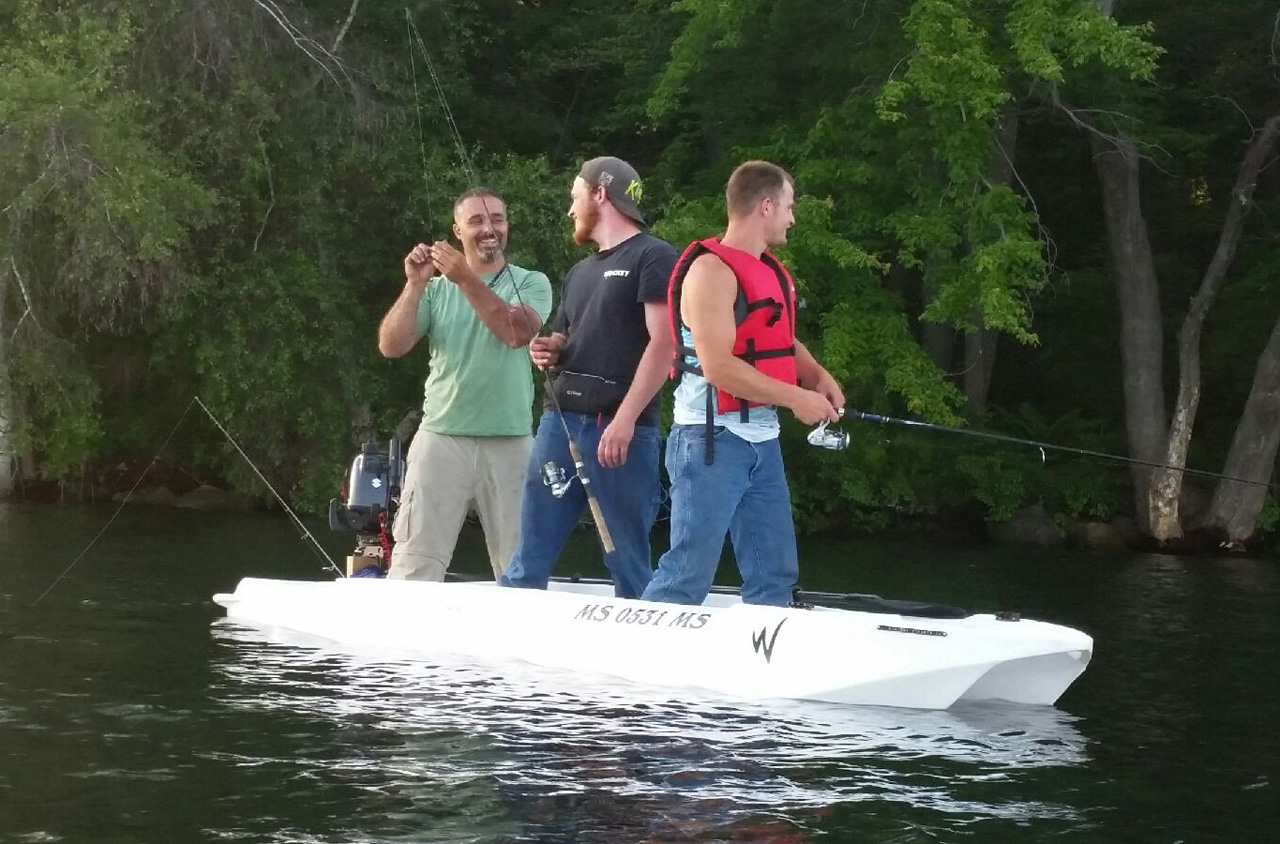
| Best Boat For Under $10,000 in 2024 |
Do you have any questions about this article?


